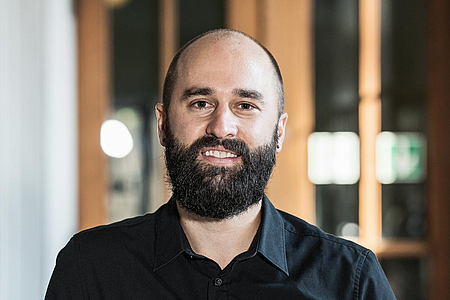The spiritus animalis – On the trail of the spirit of the Enlightenment
When characters in film adaptations of historical novels faint in droves or make extravagant gestures, it always looks very exaggerated today. The Canadian medical historian Darren Wagner researches cultural conceptions of the nervous system in the 18th century, and has a few explanations as to why those kinds of behavior patterns are not necessarily a sign of bad dramaturgy.
Dr. Wagner, before we go into the details, the title of your project already raises a question: What exactly is a spiritus animalis?
In the medical literature of the 18th century, you can’t avoid coming across this term. But, just as we know little about it today, spiritus animalis was also vague and undefined in the past. The spiritus animalis was the conception of how the nerves function. Today, we know about neurotransmitters and the electrical transmission of signals, but at that time, it was thought that some kind of liquid ran in the nerves, without an exact understanding of this substance. All that was certain was that it was able to move through the body fast and was essential for human life. They also believed that the spiritus animalis could be what connected the soul to the body. Doctors used the concept to explain health problems. It wasn’t just a physiological concept, however, but also touched on the religious and the philosophical. The concept of the spiritus animalis changed over time. In the early 18th century, a subculture developed called the “cult of sensibility”. Even a century later, in the novels of Jane Austen, for instance, the heroines regularly faint and blush as “natural” responses, which might now seem rather strange to us. Back then, such behavior was considered sophisticated and somewhat desirable. People took such gestures as reactions of their refined nervous system. Even today, we still have the expressions in English of being “in low spirits” or “in high spirits”. If you were melancholic, they thought you had a low level of spiritus animalis in your nerves. This concept was also relevant to sexuality – after all, genitals are especially sensitive parts of our bodies. It was believed that sensory impressions had an effect on the spirits. Consequently, every sensation, whether pleasurable or painful, wrought personal actions with moral consequences.
Weren’t those concepts ever used to suppress ways of behaving that were regarded as improper?
It was believed that the human seed contained the spiritus animalis. Against this background, a movement against masturbation and sexual permissiveness developed in the mid-18th century, which became an important part of sexuality and selfhood in enlightenment Europe. Luminaries like Voltaire and James Boswell delved in both philosophical and personal ways into this topic. People believed that if you were sexually very active, you lost the spiritus animalis, which could cause symptoms like melancholy or could even result in death.
But do you also study the electrical transmission of signals in your research?
Towards the end of the century, people began to reject the cult of sensibility. Part of this shift was the increasing fascination with electricity. Experiments with electricity had been carried out for several decades and had been receiving ever more attention. Thanks to experimenters like Luigi Galvani, people became aware that the nerves must also have something to do with electricity. I particularly investigate whether this shift was actually a new physiological understanding or merely a change of vocabulary.

Funding program
Humboldt Research Fellowships at BIH
Funding period
2017 – 2019
Project title
Animal Spirits to Electric Shocks: A Revolution in Enlightenment Neurology in Cultural Context
Research area
History of medicine
Institution
Charité – Universitätsmedizin Berlin
2017
Humboldt Fellowship at BIH, co-editor of the forthcoming special issue of Journal for Eighteenth-Century Studies on the theme “The Sexes and the Sciences”, completion of his book Sexual Feeling: Sensibility, Neurology, and Generation in Britain, 1650–1830 (provisional title)
2014 – 2017
Postdoctoral fellowships at McGill University, finished editing the collection The Secrets of Generation: Reproduction in the Long Eighteenth Century (Toronto, 2015) with Prof. Stephanson, Montreal, Canada
2009 – 2014
Ph.D. with Dr. Mark Jenner at the University of York, UK
When people saw electricity for the first time, was it so easy to convince them that the same thing was happening in their own bodies?
It was possible to convince many people through anatomical experiments and with demonstrations using electric fish. People could see that those fish produced electricity. So it was possible to conceive that the same thing was possible, to a smaller degree, in other living organisms too. Galvani, for instance, used frog legs to demonstrate that he was even able to move the muscles of dead animals by means of electricity.
How do such paradigm shifts occur? Does a society already have to be ready for renewal, or does it depend more on the latest discoveries?
It’s certainly a bit of both. Today, medicine has so much authority over our bodies and our health. As a society, we’re obsessed with health. At the same time, there are social, cultural and moral barriers confining medicine, whether in stem cell research or in the case of abortions. With medical practices, you should always question why certain practices exist – or don’t – and what broader ideas are behind that.
Where is one most likely to bump into you in Berlin, other than in the library?
I spend a lot of time in museums: I’m especially impressed by the art galleries here in Berlin. Normally, I try to keep leisure and work separate.
But when I’m standing in front of paintings from the 17th or 18th century, I inevitably start analyzing them and, in the worst case, thinking about connections to my research.
Have you ever used art as a presentation form in your scientific work?
A couple of years ago, I was the co-curator of an exhibition in cooperation with the Osler Library of the History of Medicine in Montreal. The theme was the history of blood in medicine and its connection with wider social concerns. The exhibition covered 500 years, from the 16th century to the present. There were interactive screens, exhibits, a film screening and lectures. I particularly liked a film we screened called Blood of the Vampire from 1958. It’s a rather low-budget and derivative horror B movie about a vampire performing murderous blood transfusion experiments in an insane asylum. The movie dates from the time when blood grouping and transfusions were still new science.
If you had it available, what object would you like to exhibit?
The Evelyn tables are kept at the Royal College of Surgeons in London: they’re four panels that date from the 17th century. Each of these panels depicts an anatomical structure – the arterial system, the venous system, and the nervous system twice. The structures were fully dissected and fixed to full-length panels. At the time that the panels were made, the concept of blood circulation had just become something that people could imagine. Often, anatomy and medicine are presented as being completely objective undertakings. However, even the way in which an object is exhibited communicates a great deal more than mere fact. It would be possible to design a wonderful exhibition on my research topics using the two panels about the nervous system and relating them to my current research on past neurology and its social meanings. I can definitely imagine preparing a small exhibition in Berlin, perhaps in collaboration with one of my favourite museums, like the Museum of Medical History.
In any case, we’re fascinated and would love to come to a movie night – whether it’s a Jane Austen screen adaptation or a vampire film.
October 2018 / MM
